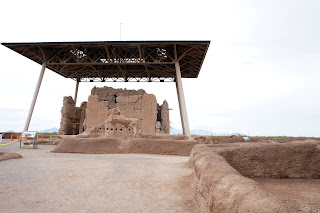 |
| Sivan Vakih |
The primary motivation to visit this monument was not only to get the most bang for the buck out of National Park Pass but also to reply in affirmative to a good friend of mine, who always queried if I visited the Casa Grande Ruins whenever I told him I was in Casa Grande. Incidentally Casa Grande Ruins is not located in the city of Casa Grande, AZ but Coolidge AZ a neighboring town. Probably the fact city of Casa Grande which was founded in 1879 during the mining boom and Coolidge was founded later in 1924 explains how Coolidge ended up with the custody of the ruins. While looking at the google maps I also saw a attraction called "Sivan Vahki". Being of East Indian heritage the word Sivan which stands for the name of a Hindu God attracted my attention and decided the added attraction is worth the detour on my journey from Phoenix to Tucson. Upon reaching the destination after several changes of mind every time it sprinkled on this cold blustery day I realized Sivan Vahki is part of the National Monument and the words "Casa Grande" in spanish and "Sivan Vahki" in O'odham mean the same thing "Big House". I also realized I had zoomed past this area quite a few times without realizing this was a archaeological site.
One enters this archaeological site through the visitor center after paying the requisite fee. There is a ranger lead tour every and a volunteer lead tour alternating every hour. As soon as I entered the exhibit hall mentally congratulating myself upon getting 5$ return upon my 80$ investment on the National Park Pass ( the fee is increased to 10$ in 2018 ) I was met with a Volunteer who introduced himself and explained the tour is about to start in few minutes and in all probability I would be the only one and if I preferred I can watch the video which is about to start soon and then take the tour the next hour which is what is recommended so one can appreciate the archaeological site and ask intelligent questions.
But I decided to do it the other way and the tour ended up being more personal one on one tour. The tour consists of a introduction to the Ancient Sonoran People and their way of life including their primitive tool set followed by a tour of the archaeological site.
 |
| Area surrounding Casa Grande Ruins |
Sivan Vahki
The main attraction of this monument is the remnants of a four story house - Sivan Vahki, built out of natural concrete like material called "caliche". The significance of this house was not entirely clear, at least to me. There are three big holes on top of this structure and one of them coincides with the direction of sun on summer solstice. One of the conjectures, as the volunteer told me, this was a multi use structure, abode of a priest, to note astronomical events of significance to their culture and probably a store house of seeds. Currently for sure it is of significance to few owls who nest there, whose glimpse I did not catch. It probably was too cold for them to say hello to visitors that day.
Building housing structures using caliche was a gradual transition in dessert dwelling where in pit houses were the norm, interestingly something in common between Eskimos and dessert dwellers. Caliche is supposed to become soft after a period of rain. Probably it takes lot more than a few sprinkles of rain to have that effect. Must have been a big nightmare to manage kids a from poking holes in the houses during monsoon season. I guess, the beauty of this housing is all one needs to fix leaks or cracks is some more caliche, pick up some caliche and plaster it. Small footprint on the environment indeed!
There is also overlook next to parking lot which is supposed to be a platform where the ancient people played ball. One can only hope they fared better than the Arizona Cardinals and Phoenix suns, local football and basketball teams.
East Indian Connection
Since I was familiar the usage of word "Siva" in the jewish culture I was intrigued by its reference in this context. However finding any link between the ancient East Indian Civilization and the ancient Sonoran people seemed far fetched to me, even under the influence of the intoxicating juice made out of Saguaro. Imagine my surprise when I stumbled upon this website Ancient India's Emperor Priyavarta Invaded Arizona! where the author not only finds quite a few parallels between the words used by ancient sonoran people and Sanskrit a ancient east Indian language, but also corroborative stories between the two cultures. It is fascinating but I did not venture to verify the authenticity of the author. However, I did find a book ancient history of India which SEEMS authentic where there is a reference to similar story of one of the sons of Priyavarta invades a land whose describes is similar to America.However far fetched the above theories might be one thing for sure, at least to my mind - all types of Indians considered land to be sacred and found god in all living creatures.
